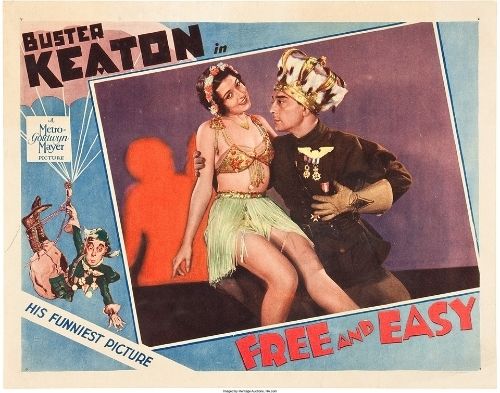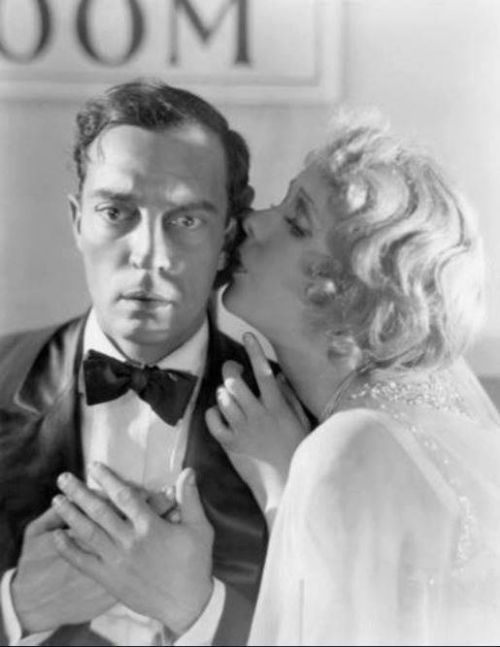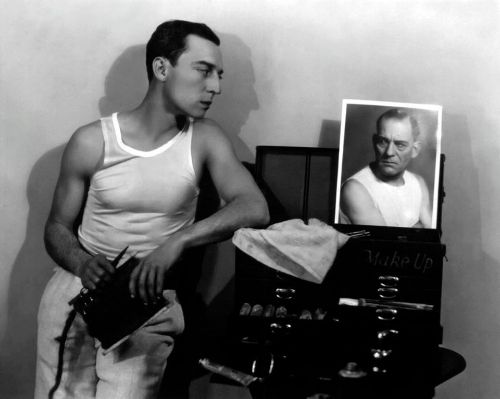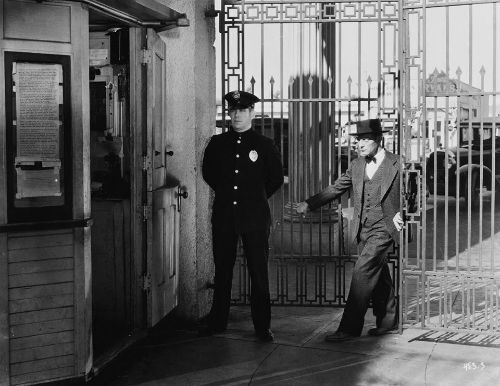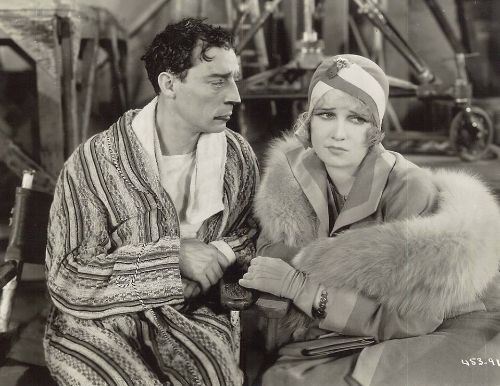The following is a transcript of my presentation on Free and Easy, which was screened at the Park Ridge Public Library on March 9, 2017.
Free and Easy is an awkward movie about an awkward time in the movies. This was the early days of talkies when sound technology was still very primitive. Films of this era were mostly stage-bound and relied heavily on dialogue. Tonight’s film is also a painful reminder that Buster Keaton should’ve remained independent. By signing at MGM in the late 1920s, after many creative years with his own production unit, he had to play by the studio’s rules. The result was that he no longer performed the feats that had made him unique. His creative input was limited, and the studio tried to turn him into something he was not. Free and Easy is not embraced by Buster Keaton fans nor is it remembered much by anyone else. But even in a lesser-Keaton film like this, there is something of value and interest. He was too great a performer for a viewer not to appreciate some aspects of this film. Additionally, Free and Easy gives us a wonderful look at the MGM studio system in the year 1930.
At this time, sound was all the rage. MGM had made their first all-talking feature the year before with 1929’s Broadway Melody. It was the first musical to win an Academy Award for Best Picture. Musicals were in, and many films of the era, Free and Easy included, had songs shoehorned into them. Not only did audiences want to see the stars of the silent era finally speak, but they wanted to hear them sing too. One of the surprises in Free and Easy is that not only does Keaton speak onscreen for the first time—in a deep, Midwestern voice well-suited to his character—but he sings. He might not be Bing Crosby, but at least that is Buster singing, unlike Robert Montgomery who is clearly dubbed by another performer in his musical scene.
In the story, Buster Keaton, as Elmer Butts, is the love-sick manager of Miss Gopher City, Elvira Plunkett, played by Anita Page. (As an aside, Elmer is from Kansas, which is where Buster Keaton himself was born.) With Elvira’s domineering mother in tow, they travel by train to Hollywood for a screen test. Along the way, Elvira meets Larry Mitchell, a Hollywood star who tries to get her into pictures. However, it’s Elmer who succeeds despite his lack of ambition and his overall ineptness. It’s a strange turn that has Elvira watching from the sidelines as Elmer and her mother appear in the movies together. This twist recalls the lost film Hollywood (1923), in which the heroine of that story fails to become a star while members of her family manage to get screen roles. In many of the “movies about movies,” there is the aspiring ingenue who becomes a great star, and we assume this will be the premise here, but the film takes a truly bizarre turn not only in its plot but also in its tone.
For most of the film we are watching a comedy, but then in the final moments it becomes something quite different. There is a tragic element that doesn’t quite fit what has preceded it. It’s actually heart-breaking, and when you see the scene I’m referencing, you have to ask yourself, “Who wanted to see this film end the way it does?” Some dismiss the final scene as sentimental and more in line with Chaplin than Keaton, but there is a power to it that Keaton brings which makes it resonate, at least for this viewer. He’s a different Keaton here, one more in tune with the great Lon Chaney; there is pain behind the mask of the clown.
The movie-within-the-movie that Elmer is filming on the set becomes a surreal, comic opera– like a knockabout version of Pagliacci with Keaton as a clownish pilot. A dreamlike fantasy with Keaton in the lead would’ve been wonderful, but studios rarely thought outside the box. Nonetheless, the scene of Buster performing the musical number “Free and Easy” is the bright spot in the sequence. The scene is successful because he is at the center of it. All too often in the film, Buster is on the periphery—off to the side of the train while other characters speak—or he’s simply the “butt” of jokes, the sap who ruins scenes and gets in the way. Other times he’s ignored or treated cruelly.
Buster is not the comic hero that he was during the silent era. Instead, screen time is wasted with a sappy romantic plot between Robert Montgomery and Anita Page who, despite appearing in Broadway Melody the previous year, does little more than look pretty here. (She would appear with Buster again the following year in Sidewalks of New York.) Free and Easy is also padded by stodgy musical numbers that play like a high school production in long shot. But this is more the result of limited technology than bad production values. MGM was the most prestigious studio in Hollywood at this time.
Robert Montgomery, Anita Page, and Buster Keaton
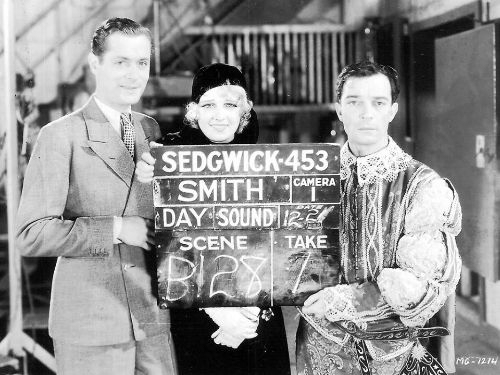
What made the Keaton character so great in the silent era was that he never played a simpleton. His characters were resourceful and he always came up with a clever way of resolving the trials he faced. For instance, there is a scene early in the film in which Elmer jumps on the train but the conductor refuses to let him pass. Instead, he remains seated at the back of the car talking to the conductor. In the old days, Keaton would’ve found some way to get past to Elvira, even if he had to climb the roof of the train. Or later in the film when he is trying to get into the studio, there is nothing particularly inventive about how he succeeds. He merely gets caught up in a horde of extras.
Throughout “Movies About Movies,” there are recurring symbols of Hollywood. In the films to come, you’ll see private swimming pools which represent the Hollywood Dream, most obviously in Sunset Blvd. But another symbol in these films is the studio gate—the main entrance. They were the passage into a glamorous world of make-believe. Time and again characters pass through the gates or are trying to. This is seen in Show People and Free and Easy, but also the ones not included in the series like Ella Cinders or Hollywood or Bust. Many times, characters enter on the sneak, run from the authorities, and get mixed-up in the shooting of a movie, as is the case with Colleen Moore in Ella Cinders. It’s a recurring plot point that gives the audience the “insider’s” view of how things were done on the other side of the gate.
Despite the pedestrian way in which the story gets Elmer into the studio, it does lead to some excitement. Keaton being pursued by the studio guard is one of the highlights in the film. During this sequence, many Hollywood notables appear including director Cecil B. DeMille. At one point in DeMille’s background conversation you hear him mention the name “Gloria Swanson.” This is ironic considering that twenty years later Buster Keaton would appear in Sunset Blvd. with Gloria Swanson—a film that has a famous cameo by DeMille! Elmer also interferes in the shooting of other films that are in-progress, including one starring Karl Dane and Dorothy Sebastian (both of whom were seen briefly in Show People). The visual gag has Buster stepping on the dynamite plunger and blowing up the set. This would be duplicated years later, to some variation, by Peter Sellers at the beginning of The Party (1968).
The longest cameo in the film is that of director Fred Niblo, who is best known for helming such silent classics as The Mark of Zorro and Ben Hur. Eventually, Elmer gets a small part in one of Niblo’s films. This leads to one of the other highlights: Elmer’s attempt to say the line, “Woe is me, the Queen has swooned!” It’s a good scene, but Keaton is clearly doing something new: being funny as a verbal comedian. Two years later, Harold Lloyd’s character would have a similar problem as he struggled through a screen test in Movie Crazy. Though there is some physical comedy in Free and Easy, it’s sadly lacking through most of the film. Some comics excelled in the early sound era because their humor was in their dialogue, most notably the Marx Brothers who had come from Broadway. But Buster had come from the silent film tradition, and with this, his first talking film, he was clearly in a new world.
The Spanish version, Estrellados
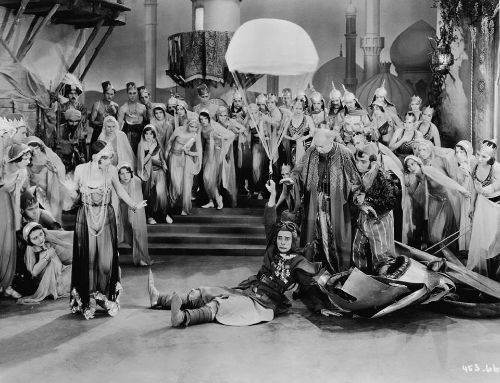
For the foreign market, Buster Keaton made a Spanish version of Free and Easy called Estrellados, which I believe translates to “Seeing Stars.” It had the same director as the English version, Edward Sedgwick. Buster was paired with Spanish-speaking actors and he said his lines phonetically. For those who have seen the Spanish versions of some of the Laurel & Hardy shorts, you’ll know that the films are not shot-for-shot re-creations of the English films. There are discrepancies, and for those who have an interest– or the patience– the dvd of Free and Easy contains the Spanish version, and there are a number of differences. One in particular that stands out is Buster’s entrance as the crashed pilot. In Estrellados, his entrance is literally explosive with him parachuting onto the set. After the film tonight, I will play a scene from the Spanish version.
Free and Easy was a success for MGM because of the novelty of sound. The result was that Buster was locked into a set formula and would play the bumbling Elmer character again. Like the image of him in Free and Easy, MGM saw him as a clownish marionette whose strings could be pulled by the great studio system. Eventually, Buster would be teamed with Jimmy Durante, marking the low-point of his career at MGM. But despite the limitations imposed upon him as a performer, note his skills as an actor. He is terrific in the film. Despite everything else going on around him, Buster Keaton the actor is always the brightest star on the screen.
Addendum: We had nearly 60 in attendance for this screening. There were several scenes that got laughs, but the biggest crowd-pleaser was the screen test in which Trixie Friganza (as Ma Plunkett) manhandles Keaton’s Elmer. This entire sequence where several women rough up Keaton got the most sustained laughter. Screening comedies with an audience is always revealing because you see what still holds up. Despite the limitations imposed on him, Keaton is amazing in the film. Unfortunately, when he’s not on the screen, the film is excruciating.
~MCH
